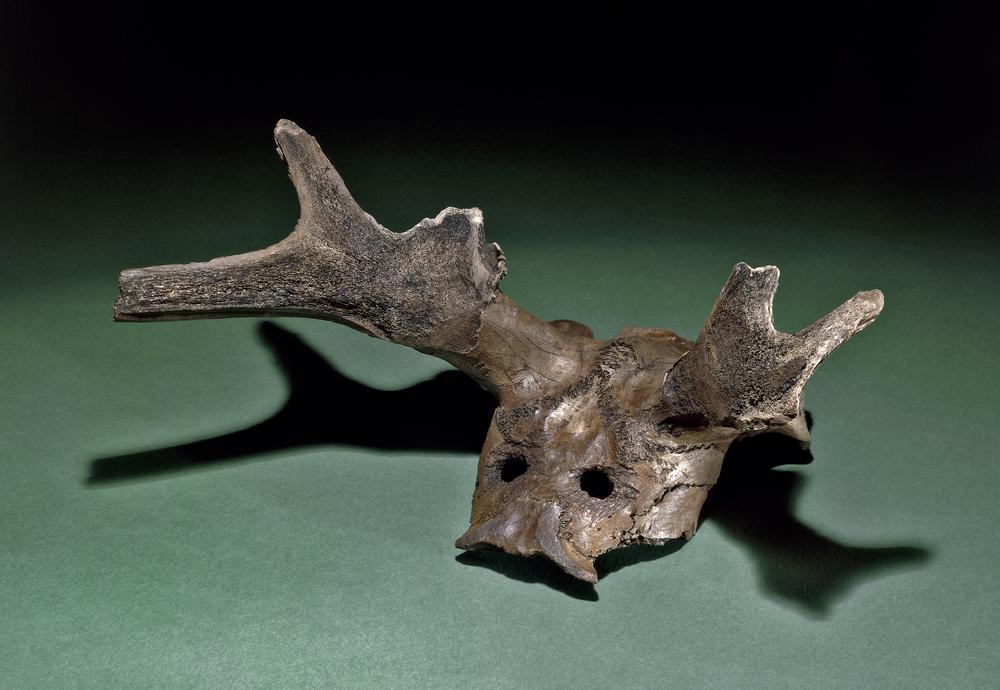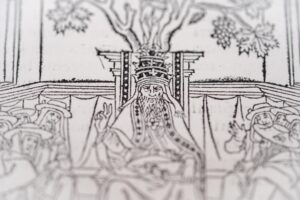In an unassuming farm field in Yorkshire, peat preserves secrets. Tens of thousands of fragments of wood, bone, antler, and stone pack into the mud beneath prim grass. Until 1948, they lay undisturbed, a time capsule from the Stone Age. Then an amateur archaeologist found remnants of habitation. Thus began a much-publicized excavation.
This is Star Carr, the most complete Mesolithic site in Britain. It paints a striking portrait of daily life just after the Ice Age, but the answers it doesn’t give are even more intriguing. Why did the inhabitants construct elaborate headdresses made of deer antlers? What was carved into the oldest jewellery in Britain? And what did they do with their dead?
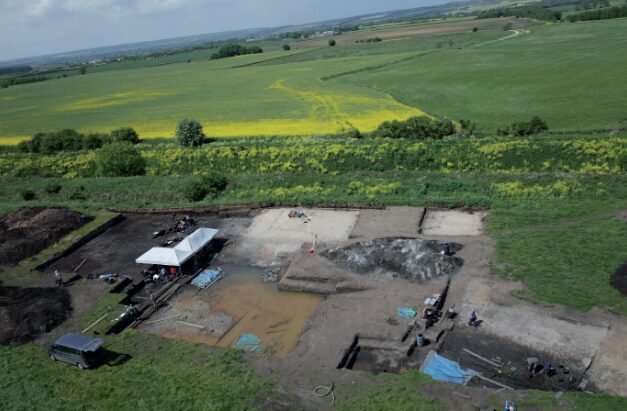
The 2015 excavations at Star Carr. Photo: Taylor et al, 2019
Treasure trove
At the time of Star Carr’s discovery, the British Mesolithic (from about 15,000 to 5,000 years ago) lacked for evidence. The Neolithic that followed had Stonehenge, but the Mesolithic only had hints of stone knapping and some fragments of bone. Then came Star Carr, named for the modern farm below which lurked history.
Inhabited for at least 800 years at the end of the last Ice Age, Star Carr sat at the side of a lake that no longer exists. The long-gone Lake Flixton hosted at least 16 sites of human activity, including three on islands, but Star Carr was special.
The original excavations in the 1950s found evidence aplenty for stone working, hunting, and the now-iconic antler frontlets. Generally made from red deer antlers, the frontlets featured boreholes presumably used to fasten them onto heads. Some were only nubs of antler, lightweight and purposefully shorn. Others extended out to the side in dramatic branches. Their purpose remains unknown.
When archaeologists returned in the 2000s, they found that exposure to the modern climate had destroyed much of the early digs. What had been peat-logged bone decades before was now mere jelly. For over a decade, archaeologists raced to save the rest of the site. They found more antler frontlets, as well as the first known house in Britain and the first known artwork.
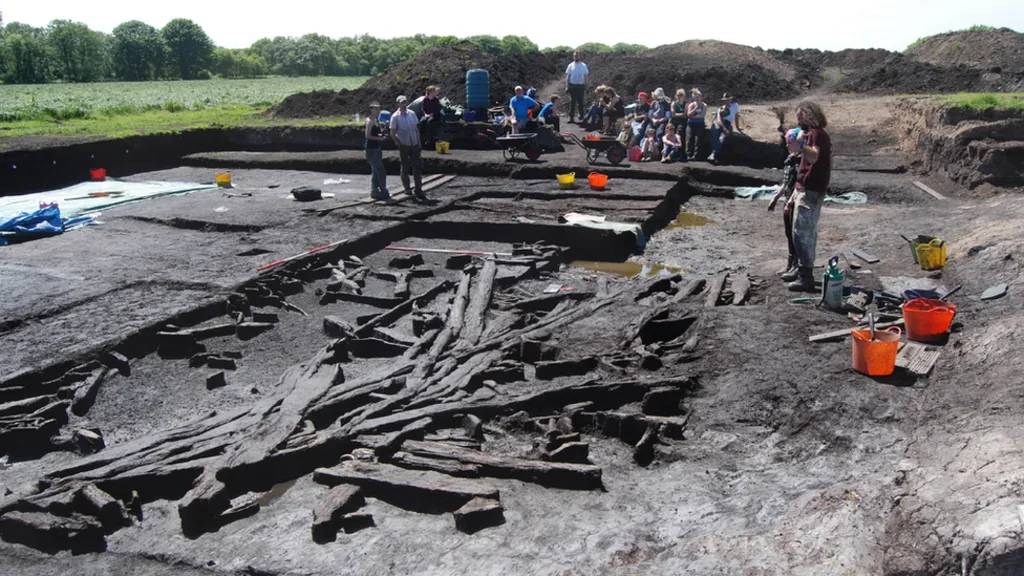
Peat preserved organic matter at Star Carr for 11,000 years. Photo: Star Carr Project
Stone Age capital
Star Carr offers a singular view of the technology of Mesolithic people in Britain. Post holes show where structures once stood, one as large as 3.5m in diameter. Split timber beams line the shores of the lake, the first known carpentry in the Isles. They may have been used for traversing the waterlogged shore, mooring boats, or both.
The other sites around Lake Flixton aren’t anything like Star Carr. They feature remnants of habitation, including stone knapping, but Star Carr was a center of industry. Probably inhabited during the spring and summer, its cultural status survived at least one century-long dip in temperature.
Star Carr is so extensive that it has filled in many details of everyday life in the British Mesolithic. We know that they ate perch, pike, and even hedgehogs. We know that domesticated dogs played an important role in their community and were laid to rest on the shores of the lake. Also given special treatment in death was the red deer, whose antlers and bones became both tools and ritual objects. At least, archaeologists have to assume the antler frontlets were used in rituals.
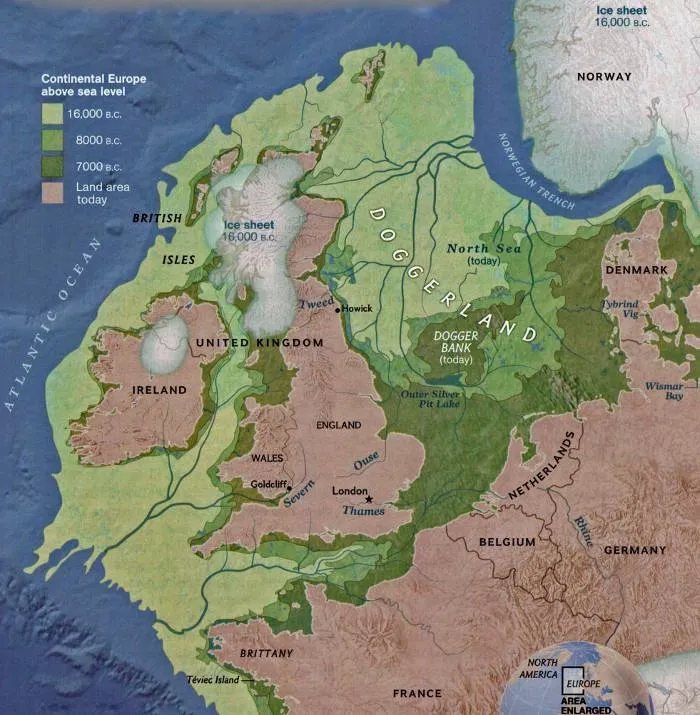
A reconstructed map of Doggerland, which used to connect the British Isles to the European mainland. Photo: Europe’s Last Frontiers Project
Before the Isles were islands
When humans lived at Star Carr, the British Isles weren’t Isles yet. A land bridge stretched from the coast of western Europe to what is now England. Called Doggerland, this real-life Atlantis was lost to rising sea levels at the end of the last glacial maximum.
Star Carr stands as a testament to this lost connection between the mainland and England. The only other known examples of antler frontlets are in Germany, where their purpose is also shadowy. Why were some cut down to the base of the antlers, while others extended out to the side? Why were they found deposited on the peaty lakebed? Who wore them, and why?
On this point, Star Carr offers no answers. Artifacts such as the antler frontlets hint at a rich cultural life but do not elaborate.
First art in the British Isles
In a similar category, the Star Carr pendant shines as the first example of art in the British Isles. Found by a student at the tail end of the excavations in 2015, the pendant is a small, triangular piece of shale with a borehole at one end. Engraved lines layer its surface. They bear a passing resemblance to those on Mesolithic pendants from mainland regions like Denmark. But mainland pendants were almost always made from amber, not shale.
The carved lines are enigmatic and obscure. In the discovery paper, the excavation team says that they showed various colleagues the pendant. Their interpretations “included a tree, a map, a leaf, tally marks, even a representation of the wooden platforms which have been found at Star Carr.”
Many of the artifacts at Star Carr lie in giant piles. The archaeologist who led the 1950s excavation interpreted them as midden piles, but modern archaeologists disagree. Why would the inhabitants of Star Carr lay only arrowheads and axe heads to rest in the lake if they were disposing of them? Why not the whole arrow or axe? What is the meaning of those antler frontlets? And why bury red deer and dogs along with them, but no other animals?
“Radiocarbon dating of artifacts and animal bones has shown that the assemblage was generated over a very short period of time, perhaps in a single event,” wrote team lead Nicky Milner of one of the most dramatic such piles.
Again, Star Carr taunts us with its eternal question: What did this mean to the people who made it?

The pendant at Star Carr is on display at the Yorkshire Museum. Photo: Wikimedia Commons
Where are the dead of Star Carr?
Archaeologists have found the remains of many animals at Star Carr. Some, like the red deer and the dog, clearly played important roles in contemporary society. Others were food. But this site’s Rosetta Stone, which cracks the code, has yet to be found.
Despite being inhabited for over 800 years, Star Carr does not have any human remains.
Negative evidence is always tricky in archaeology. But given the evidence for ritualistic burials of red deer and dogs, the lack of human bones anywhere in the excavations is striking. It’s not just Star Carr, either. No sites around Lake Flixton feature any human graves.
Presumably, humans did die at Star Carr. That leaves two options: either their bodies were carried to the ocean for disposal, or they were destroyed in a way that left no archaeological trace.
“This may have included practices involving the disarticulation of human bodies through excarnation and dismemberment,” writes the excavation team. “Equally, bodies may have been cremated.”
These, then, are the people of Star Carr: not nomads, but seasonal dwellers. Hunters and fishermen, who used not just stone but also bone and antler to create their tools. Voracious omnivores who roasted hedgehogs in clay to remove the spines, just like Romani British would do millennia later. They made jewellery and elaborate antler headdresses, built docks, and loved their dogs.
Then they died and disappeared from the archaeological record.
